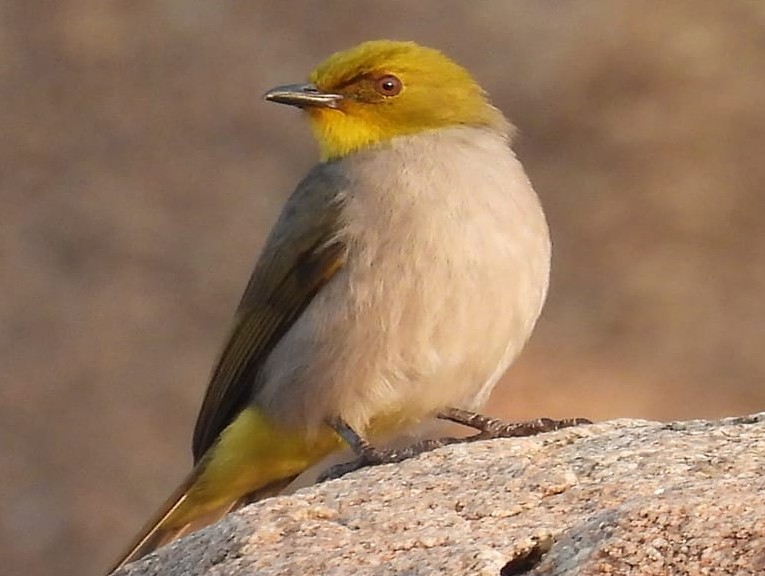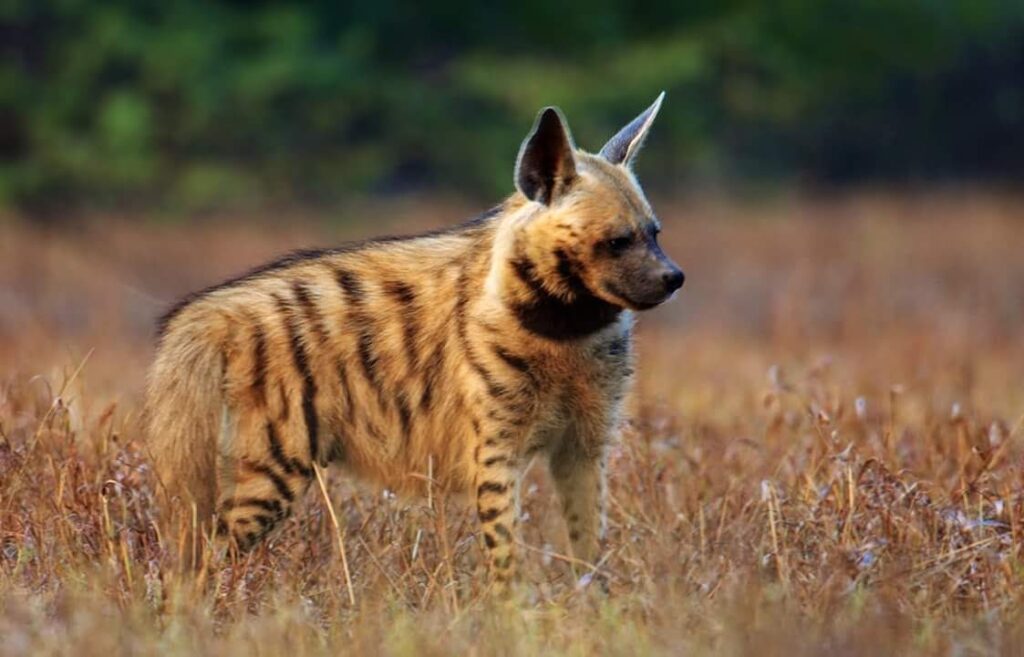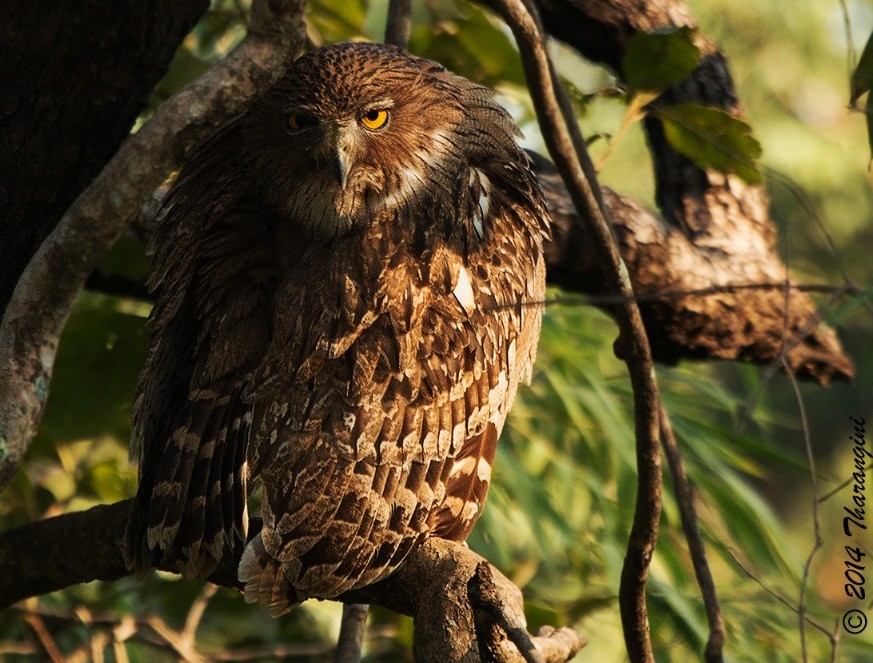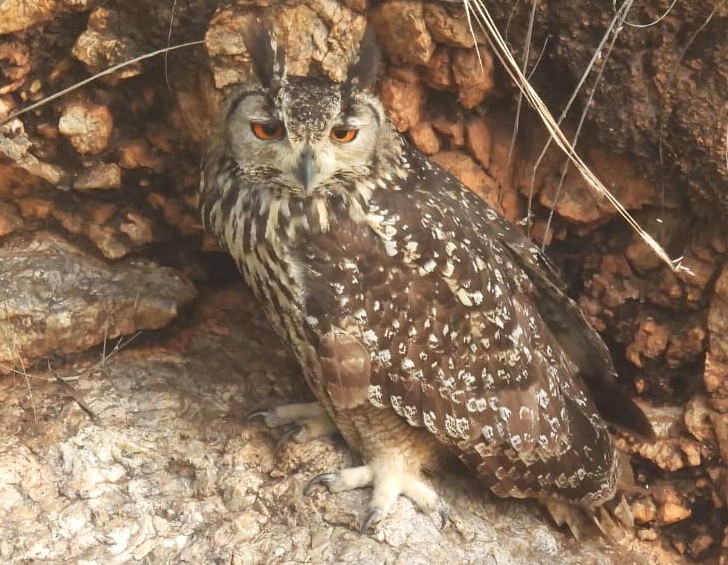
Meera Bhardwaj:
A rarely seen bird species – the Indian Scops Owl has been sighted at World Heritage Site of Hampi, Karnataka, India. Observed in Daroji Sloth Bear Sanctuary, the Indian Scops Owl, (although said to be distributed around Hampi), it has never been recorded or photographed. Also known as Collared Scops Owl, it is an expert at hiding itself as it has excellent camouflage abilities. It can be heard but has hardly been seen by birders.
The rocky scrublands of UNESCO World Heritage Site of Hampi are considered as an excellent habitat for different kinds of birds with “SEVEN OWL SPECIES” recorded in the biodiversity rich region. The sloth bear and the yellow-throated bulbul are the flagship species associated with the Hampi region. Around 200 bird species are found here with star attraction being yellow throated bulbul, painted sandgrouse, painted spurfowl, etc.

The remnants of the architectural ruins of the Vijayanagar empire and the rocky hilly terrain with its scant shrubs on the banks of the mighty Tungabhadra River, is a thriving ecosystem for many mammals, reptiles and birds. Virupaksha temple, Varaha temple, Matanga hills, the Malyavantha Raghunath temple, the Kondandarama temple, and other ruins are home to many bird species and Hanuman Langurs and Bonnet Macaques.
Hampi is a natural habitat for sloth bears, leopards, striped hyenas, smooth coated otters, monitor lizards, Indian Mongoose, star tortoise, pythons, yellow throated bulbul, owls, painted sandgrouse and a plethora of other species.

To stop illegal mining, Naturalist Pompayya Malemath, Kamlapur add, “These species which have been sighted and recorded by birders have to be authenticated by KFD. Further, there have been incidents of cutting of bushes which is the habitat of Yellow Throated Bulbul. The preferential habitat of the Indian Scops Owl is abandoned and dead trees as they are a camouflage species and they need protection from the KFD.”
Speaking to Green Minute, Anupama H, Deputy Conservator of Forests, Vijayanagara division said, “There are recording of many bird species in Daroji Sanctuary and we have a check list of this and we have documented it. It is a continuous process of documentation whenever any bird species is sighted. And documenting is done as per the Management Plan of Daroji and in fact, the Indian Scops Owl is found in Hampi and southern part of India.”

NEED FOR IMPACT STUDIES BY KFD
Appealing to the Karnataka Forest Department (KFD) naturalists and birders have called for documentation and complete studies of many a rare bird species in Hampi. These species have been sighted in and around Daroji Sloth Bear Sanctuary in the recent times. Since the formation and notification of the Daroji Sloth Bear Sanctuary, there has been no impact assessment studies, naturalists say and add the presence of these species has to be authenticated by the Karnataka Forest Department.
DCF Anupama adds, “Impact studies is a very good suggestion by birders and others. Compared to Nagarhole and other PA, there are many flagship dryland species in Daroji and outside. We will consider the suggestion and as it is, already under the Daroji Sloth Bear Sanctuary Management Plan (2020-21 to 2029-30), there is a Research and Monitoring component added to it under KMERC. Further, we are carrying out habitat improvement, ecological restoration, removal of lantana and other such activities so that wildlife species can thrive and be protected.”

P C Sridhar Perumal, Wildlife Photographer captured these pictures of Indian Scops Owl in and around the Daroji Sloth Bear Sanctuary on Saturday night (October 18th) at 10.30 pm. In fact, Hampi, situated in the Deccan Plateau region with rocky hilly terrain and scrub forests and grasslands, has a rich biodiversity and is a repository and treasure house of various faunal species including many dryland birds.
Malemath adds, “Although, the Indian Scops Owl was said to be distributed in Hampi, Vijayanagar district but till date, there was no photographic record or evidence. For the first time, we saw a direct sighting of Indian Scops Owl as it has never been seen anytime.”

With this, the World Heritage Site of Hampi has recorded seven owl species:
- Great Horned Owl
- Indian Scops Owl
- Indian Eagle Owl
- Mottled Owl
- Brown Fish Owl
- Barn Owl
- Spotted Owlet

He further adds, “Hampi is a treasure house for many bird species and the last few decades, we have seen and recorded many rare species in and around Daroji Sloth Bear Sanctuary. Mottled Owl has also been observed which is a rare sighting. In this background, we are hoping the KFD carries out scientific documentation and complete studies in and around Daroji for its protection.”
Further, the Rusty Spotted Cat too has been sighted and recorded in Hampi bringing three cheers to many birders who flock to this heritage destination from all over the world. Chaya Sunil who is a wildlife photographer and teacher from Hunsur, Mysuru district photographed the elusive Rusty Spotted Cat at Hampi for the first time at Hampi.

Chaya Sunil said, “I sighted the Rusty Spotted Cat inside the Daroji Sloth Bear Sanctuary when I was observing birds. This was sighted in December 2024. There was only one animal and it was there only for a minute or so and I managed to capture it on my camera. I couldn’t identify the species but later after identification, I was very happy as it is for the first time, this species has been sighted in Hampi.”
Apart from this, the Rufous Frontal Prinia has been directly sighted in Hampi. This year, birders have recorded and photographed this rare bird species. Other bird species that have been observed and recorded recently in Hampi include Brown Rock Chat which is an endemic species to Central India.

Apart from the flagship speciesof Sloth Bear & Yellow Throated Bulbul , the recent sightings and observations of varied birdlife and other wildlife demonstrates that Hampi is not just a World Heritage Site but it should also be declared as a World Biodiversity Site, opine wildlife conservationists, naturalists and birders.
